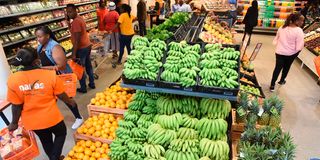Recession creeps up in the wake of soaring energy and food bills

Customers shop at Naivas Elgon-View Supermarket in Eldoret, Uasin Gishu County.
In 2020, Kenya succumbed to the economic effects of the pandemic and declared the first recession in two decades. There was hope for recovery in 2021. However, recovery to date has been slow.
This is not a unique situation to Kenya as the world is grappling with an economic downturn. Many economists have suggested ways to lift economies out of recession, however, the solution is not linear or simple. Daniel Hannan famously said, “You cannot spend your way out of recession or borrow your way out of debt”.
Kenya has large foreign and national debts which are to be paid with interest, as is the case with most indebted nations. Amassing foreign debt is of concern as currency exchange losses make a detrimental impact on the financial health of an economy. Kenya’s foreign reserves are being depleted by elevated external debt servicing obligations and recently Fitch Ratings downgraded Kenya’s credit rating from “B+ to B” owing to mountainous foreign debt.
One of the reasons there is a lot of concern about the global recession over the past two years is because of impacted livelihoods and loss of incomes compounded with the rising prices of energy products and food. This has caused significant problems in many countries around the world. Natural gas, Brent crude oil and wheat prices over the last two years have increased.
Gas price increase
With the Covid pandemic taking centre stage in 2020, workplaces, industries, and economies were impacted. Supply chains were affected and we started to see an increase in natural gas prices. Those price increases took off dramatically following Russia’s invasion of Ukraine in early 2022 and prices have remained high. As per statistica, “global demand for crude oil including biofuels in 2020 fell to 91 million barrels daily and increased to 96.5 million barrels per day in 2021, and the upward trajectory continued in 2022.”
In October there were news headlines of “OPEC and its allies agreeing to slash oil output by 2 million barrels a day to prop up oil prices.” At the beginning of December 2022, there was some correction to the price of fuel and global oil prices fell to below $80 a barrel for the first time since January, on persistent fears of a recession and rising interest rates by central banks worldwide.
However, with oil-producing nations having the globe at their mercy and OPEC countries coordinating supply cuts when they deem prices to be too low, the situation is causing global economies to suffer blows during times of recession.
Most of Europe is dependent upon natural gas. The European power industry over recent years has built several power stations that need natural gas as the raw energy supply, and the main supplier of that gas over the last 10 years has been Russia, which built pipelines which supplied all European countries directly. Since the war started, European countries have made a commitment to stop buying Russian gas. Some of them had their supplies cut off by Russia or they made a conscious decision not to buy any more gas from Russia.
The rest of the countries are in the process of transition. They are moving away from Russian gas, but the problem that many countries have is that it is not easy to find alternative piped gas, and therefore they are having to buy Liquefied Natural Gas that involves a heavy investment into all of the infrastructure needed to convert the LNG back into natural gas.
The price of gas globally has gone up drastically and is likely to stay high for at least the next 12 months. The output slash by OPEC countries has not been helpful in this aspect.
Crude oil prices have a similar pattern. In 2019 crude oil prices were flat. As the world went into the pandemic, global demand slowed down and oil prices actually fell. However, as economies emerged from the pandemic, demand for travel, production, and transportation suddenly spiked after a period of lull, and oil prices started to rise exponentially. The prices spiked further following Russia’s invasion of Ukraine. However, oil prices have started to come back down as a result of the slowdown in global demand caused by the potential global recession.
Where food is concerned, for instance, up to the middle of 2020, wheat prices were broadly flat. As the pandemic started, wheat prices started to increase, and there was a jump in prices after Russia’s invasion of Ukraine. Wheat prices are significantly higher than they were this time last year. Wheat is a very basic food substance used to produce flour which makes up a significant percentage of the global population's diet.
These rising prices compound the fact that global incomes have been affected. Individuals barely have spare disposable income and savings.
Inflation
Between 2000 and 2021 the average rate of inflation across the world was approximately 3 per cent. There have been some fluctuations. In 2008 there was a global financial crisis. Average rates at that time in 2008 increased quite significantly and grew to approximately 4.50per cent which represents a 50 per cent increase on the long-term average.
However, more recently, over the course of the last 18 months, economists are now very concerned about the global economy because there has been a dramatic increase in average inflation rates. This is by far the biggest movement that the world has seen at any time over the course of the last 22 years.
Since the onset of the pandemic, many countries operated strict Covid lockdown policies during 2020-2021 and as those policies started to be relaxed, there was pent-up demand. People wanted to go out, buy items, travel, and enjoy life. This led to a combination of a boom and demand during short supply. Shortages of production were evident because many companies closed down their facilities during the peak of the pandemic.
The mismatch between supply and demand forced prices up. At the start of 2022, most economies were determined to control inflation. Unfortunately, when Russia invaded Ukraine, we saw a huge increase in energy, food and commodity costs. That meant inflation went higher. Inflation moved upward to record levels up to 12 per cent causing significant concerns.
Economies wishing to grow generally stimulate the economy by using quantitative easing. The other way of trying to stimulate the economy and encourage people to spend more is to reduce interest rates to discourage savings and encourage spending. However, this is not appropriate in current conditions, especially with regard to controlling inflation.
Central Banks across the global economies are concerned that the economies are going into recession.
One of the problems with quantitative easing and reducing interest rates is that it often leads to high inflation and that is exactly what is happening over the course of the last 18 months the situation has been worsened by Russia’s invasion of Ukraine. In order to curb inflation, central banks are doing the opposite of quantitative easing.
The Central Banks are practising quantitative tightening, so rather than buying bonds they are selling bonds into the markets, they are taking cash from the financial institutions, which means that the money supply should reduce and at the same time and increased interest rate encourages savings thereby curtailing unnecessary spends which is prudent in this situation. Oil, gas, wheat prices, debt, and inflation leave little space for world recovery.
Ritesh Barot is a business and financial analyst [email protected]





